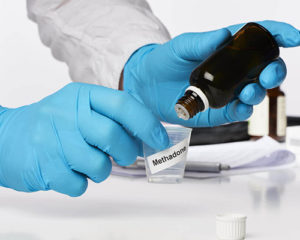A rampaging drug crisis, well into its third wave, has compelled lawmakers, regulatory officials, and the medical establishment to intervene. In 2014, the U.S. Drug Enforcement Agency (DEA) rescheduled hydrocodone medications into a stricter controlled substance category. Meanwhile, opioid prescriptions have continued to dip since 2011, while new users of treatment medications formulated to alleviate withdrawal symptoms and cravings have rapidly increased.
Prescription opioid volumes have declined by 29 percent between 2011 and 2017. However, there is still enough for every American adult to have 52 pills, according to The New York Times.
The third wave of the opioid scourge, more than 20 years old now, is being fueled by the deadly synthetic opioid fentanyl, which is capable of shutting down your breathing in less than a minute. And despite the efforts of those from the law enforcement, political, and medical sectors, fentanyl-involved deaths in the U.S. continue to skyrocket.
What’s more, there’s a common narrative around opioid-involved death, and it often plays out in this manner, whether someone uses a prescription or illicit opioid product: an addicted person attempts to quit on their own, only to relapse and succumb to a fatal overdose.
If there is one solution that can help reverse this trend, it is offered through professional addiction treatment. A reputable treatment program provides a medically supervised detox process that allows the addicted to taper off opioids safely and comfortably through a method known as medication-assisted treatment (MAT).
Read on to learn more about opioid tapering, MAT, and professional addiction treatment options.
Why Opioids Are so Addictive
Opioids, such as oxycodone, hydrocodone, methadone, heroin, and morphine, typically do not produce life-threatening withdrawal symptoms like alcohol or benzodiazepines.
Still, the symptoms that opioids generate feel like the flu, and for people going through it, this phase seems interminable. In actuality, the flu symptoms last between seven to 10 days.
One woman, who chronicled her opioid withdrawal experience for Tonic, summed it up like this:
“It feels like the worst flu you ever had, the sickest you’ve ever been, times suicidal thoughts and complete and total confidence that you are never, ever, ever going to feel better.”
Opioid withdrawal symptoms occur in two phases, including specific and physical symptoms. The first phase of symptoms after opiate use stops includes:
- Muscle aches
- Joint pain
- Agitation and restlessness
- Anxiety and nervousness
- Increased watering of the eyes
- Runny nose
- Excessive yawning
- Fatigue
- Insomnia
- Sweating
The second phase of withdrawal can include symptoms such as:
- Diarrhea
- Nausea and vomiting
- Other stomach and intestinal cramps
- Dilated pupils
- Cold shivers
- Goosebumps
The Tonic writer adds that the only thing that can make those symptoms go away is more opioids. Why? Because the drugs profoundly impact the brain’s reward pathways that people will relapse due to the cravings and withdrawal symptoms.
When people return to using opioids, that’s when the drugs can turn deadly, according to addiction expert Sherry Benton.
“People tend to go back to the level of the drug they were taking when they used, but they no longer have the tolerance, and now it’s enough to kill you….”
Opioid Overdose
An opioid dependency will most likely lead to overdose. In fact, the World Health Organization (WHO) lists the following criteria as risk factors for overdose:
- Opioid dependence or addiction
- People who combine opioids with other drugs such as alcohol or benzodiazepines
- People who have co-occurring medical and psychological disorders like HIV (human immunodeficiency virus), liver or lung disease, or depression
- People who abuse prescription opioids
- Injecting opioids intravenously (typically more potent)
- Other people in a household of someone who has opioids, including prescriptions
Because heroin and other opioids work to relax you, users often close their eyes. When they become unresponsive, that is when an overdose could be occurring. The three symptoms common to most overdose cases are known as the opioid overdose triad:
- Dilated pupils, often described as pinpoints
- Unconsciousness, or slipping in and out of consciousness
- Respiratory depression, which is slowed or stopped breathing
Fatal Opioid Overdose

When someone has a fatal opioid overdose, the drugs restrict breathing to the point that it stops altogether. This is called respiratory depression. It’s worth noting that non-fatal overdoses are several times more common than fatal opioid overdoses.
However, with the rise of fentanyl, whether it is used by itself or ingested via heroin or cocaine, fatal overdose has become a lot more common.
Fentanyl, which is 30 to 50 times more potent than heroin, was responsible for more than 18,000 overdose deaths in 2016. In 2011, fentanyl just accounted for 4 percent of all drug deaths. In 2016, that number rose to 29 percent, according to the U.S. Centers for Disease Control and Prevention (CDC).
It is unlikely that the average heroin or cocaine user will encounter a pure form of any of those drugs. Dealers are adding fentanyl to heroin and cocaine to stretch product and enhance potency, making the average user more susceptible to fatal overdose.
This is why professional addiction treatment that allows people to taper off opioids under medical supervision is critical.
Medication-Assisted Treatment and Tapering
Medication-assisted treatment, or MAT, is the use of approved medications to treat opioid and alcohol addictions. MAT is viewed as an effective approach to treating opioid addiction when combined with therapy and counseling.
The Substance Abuse and Mental Health Services Administration (SAMHSA) states that, “MAT programs provide a safe and controlled level of medication to overcome the use of an abused opioid. And research has shown that when provided at the proper dose, medications used in MAT have no adverse effects on a person’s intelligence, mental capability, physical functioning, or employability.”
The following drugs are most often employed in MAT to treat opioid dependence:

Methadone: This is a controversial medication used to treat heroin addiction. When methadone is administered under medical supervision, it allows a recipient to safely taper off of the original opioid while relieving cravings and withdrawal symptoms. Methadone accomplishes this by binding to the same opioid receptors as heroin. As a maintenance medication, it requires long-term use, and it can produce withdrawal symptoms on its own. Sometimes methadone maintenance can last from a few months to several years. In some cases, it is used indefinitely over a lifetime.
Buprenorphine: This medication works like methadone in that it treats opioid addiction. It binds to the same receptors in the brain but produces far weaker effects, allowing users to avoid withdrawal symptoms or cultivate an addiction to it. Buprenorphine combined with naloxone is sold under the brand name Suboxone, which is utilized during withdrawal detoxification.
Naltrexone: This is the only MAT drug used for alcohol and opioid addiction treatment. It works by blocking the euphoric or sedative effects of a substance. The idea behind naltrexone is that it removes the psychological reward that comes from taking opioids or alcohol.
Tapering and Professional Treatment
Opioid addiction, the most serious and acute epidemic of our times, requires the kind of evidence-based solutions provided by a professional treatment program. A program of this sort offers a full continuum of care to address a person’s mind, body, and soul.
A professional program starts with medical detoxification, a process that is conducted under acute treatment.
Patients can be provided access to MAT medications like buprenorphine in detox to wean them off of opioids, safely and comfortably. Buprenorphine can be provided as a maintenance medication beyond detox and throughout treatment.
Opioids are so psychologically addictive that they require comprehensive therapy and counseling, the kind offered through clinical stabilization services, in combination with MAT. This phase occurs after detox, and it is where clients receive treatment that gets to the underlying causes of addiction.
The treatment and counseling services offered in clinical stabilization include:
Holistic treatments
- Reiki
- Yoga
- Meditation
- Nutritional assessments
- Stress Management
Group therapy
- Emotional regulation
- Medical education
- Motivational enhancement
- Relapse prevention
- The 12 steps of recovery
- Wellness skills
Individual therapy
- Cognitive behavioral therapy (CBT)
- Dialectical behavior therapy (DBT) skills
- Genetic testing
- Family-focused therapy
- Trauma-informed sessions
Clients can continue to receive therapy and counseling through outpatient care on a part-time basis. An outpatient program can occur after clinical stabilization is complete.
Once treatment is done, clients can get connected to a recovery community that provides long-term support, which provides a hedge against relapse.

